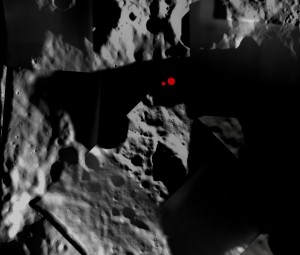The Coming Crash
Friendly warning: Do not be in the moon’s Cabeus Crater tomorrow morning. At 7:31 eastern time, a giant, two-and-a-half ton empty rocket stage will come crashing down from the sky at 1.5 miles a second. Four minutes later, another, smaller spacecraft will hit near the same spot. What the…? Ahh, i…

Friendly warning: Do not be in the moon's Cabeus Crater tomorrow morning. At 7:31 eastern time, a giant, two-and-a-half ton empty rocket stage will come crashing down from the sky at 1.5 miles a second. Four minutes later, another, smaller spacecraft will hit near the same spot.
What the...? Ahh, it's just NASA scientists looking for water again.
The Lunar CRater and Observation Satellite (LCROSS) and its Centaur rocket stage will smash into the moon so scientists can inspect the material that flies up for the spectral signature of water. Some 350 tons of debris from the Centaur impact is expected to rise miles above the lunar surface. The smaller LCROSS spacecraft will spend its final minutes flying through the spray, searching for water, before it, too, crashes into the moon. Then a variety of Earth-based telescopes will scrutinize that debris.
A few thoughts about tomorrow's impact:
- The advertised purpose of the experiment is to settle once and for all whether there's water ice in permanently shadowed "cold traps" near the lunar poles. How likely is LCROSS to put the matter to rest? After all, the Lunar Prospector spacecraft was sent smashing into a crater very close to Cabeus 10 years ago, for this very purpose, and saw nothing. But that experiment, a last-minute add-on to the main mission, was always given low odds of success. LCROSS was designed from the start to observe an impact with spectrometers that can detect water. The Centaur is a much bigger impactor, coming in at a steeper angle—which means a lot more energy will be delivered to the target, under much better observing conditions. That makes it more likely we'll see something this time. But hitting the right patch of ice, in the right crater, under the right viewing conditions, is trickier than it sounds. So if LCROSS finds no water, the scientific argument is likely to continue. There will always be another place to look.
- Don't expect a big, dramatic explosion. Even though NASA has invited the public to watch and report what they see, this is not a viewer-friendly event. The impact happens after sunrise in the eastern U.S.—bad luck, but lighting conditions at the moon were more important. The visible flash will last only a tenth of a second (although the rising plume of debris should appear for half a minute). And you'll need at least a 10-inch telescope to see anything, even the barest smudge, which rules out all but serious amateur astronomers. "The best place to observe it is online," says LCROSS project scientist Anthony Colaprete.
- Still, LCROSS is cool, and not just in the SCTV "blow it up real good" sense. The final pictures from the spacecraft as it kamikazes into the moon will be fun to compare to the Ranger photos from the 1960s.
- By the way, here's what a crash site on the moon looks like. (The picture was just released today from LCROSS's "parent spacecraft," the Lunar Reconnaissance Orbiter.)